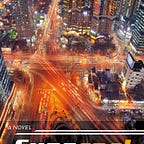The 3 Korean Temples You Shouldn’t Miss
A few years ago I decided to embark on two crazy errands. The first was to write a novel set in South Korea without any non-Korean characters whatsoever (Funereal, a book which turned out to be the first of its kind). The second was to leave my home in the UK to live in and travel around South Korea as research for my fiction. Otherwise, as a young author, I really would have been more arrogant and stupid to take up the project than I already was in the first place.
My home of choice was Seoul, as that’s where my novel is set, but soon enough I wished I’d lived elsewhere in the country, free of the hubbub that defined both the capital city and my writing. In order to escape this daily turmoil, I often found myself seeking out places of tranquillity amidst the chaos, and it didn’t take too long to become fascinated by the many temples you can find in Korea, immersed in their own little pockets of calm. Case in point, the amazing Wawoojeongsa.
The little known temple of Wawoo is referred to as Wawoojeongsa in Korean, and can be found in Seoul’s surrounding province Gyeonggi, in the city of Yongin. To be exact, it’s nestled in the almost prehistoric-looking mountain of Yunwha, and is a one of a kind place due to the massive Buddha head that marks the centre of its massive courtyard. Rumours say the head was part of an unfinished project to create a giant Buddha figure, one that ultimately got stymied by a lack of funds.
To find Wawoo Temple, get low fare bus 5001 or 5002 from exit 10 of Seoul’s famous Gangnam underground station. The bus will be bound for Yongin Intercity Bus Terminal (용인공용버스터미널). Get off here and take another low fare bus, this one bound to Wonsam ( 원삼). After 15 or so minutes, you’ll be at the stop for the temple, Wawoojeongsa (와우정사).
Another similarly beautiful temple is one of the two golden temples to be found in South Korea, Seoul’s Suguk temple, or Suguksa, as set up in 1459 by King Sejo in honour of his deceased son.
The temple was intended to provide treatment for royals afflicted by anxiety and other mental ailments, and became so respected that one king offered riches and a seat in the government for its chief monk following the successful treatment of his son. The monk declined his offer, and instead requested a gold-covered Buddhist sanctum to be built in the grounds of the temple for ordinary citizens, the very people whose taxes he didn’t wish to take as reward from the king based on principle. The building we see today is this sanctum, and the unique colouring of this beautiful temple comes from the special gold paper used to decorate its ancient walls.
Although the part of Seoul that is home to the temple is a typically busy and urban one, you’d be still surprised how stone dead quiet this whole area was, and how the city just seems to fall miles into the background. Most temples in Korea are found in this way, as built on sloping hillsides and mountainsides that jut away from the hubbub. This is one reason why Suguksa is largely unknown, much like the smaller temples dotted around Korea’s capital city in this secretive manner.
To get to the golden temple of Suguksa, venture out the third exit of Gusan Subway Station on Seoul metro Line 6 (구산 station in hangul). Take a right, where there’ll be a pharmacy on the corner of the street with a Dunkin Donuts to its right hand side. Walk straight past the stores, and keep going straight for 15 minutes until you see a sign with ‘수국사’ in hangul, upon which you take a left up into the grounds of the temple.
My last temple is probably the newest of the three, and is another hidden gem in Seoul metropolis. The wooden temple of Cheongan aka Cheongansa is unique in that it’s one of the few temples you’ll see in Korea devoid of the green, white and red paint usually used to decorate them.
To get to Cheongansa is easy — simply venture out Exit 1 of Dokbawi Subway Station, which, like the previous temple, is also on Seoul metro Line 6 (독바위 station in hangul). You’ll see a sign for the temple with its name in hangul (천간사). Follow this past a few shops to walk up a small incline. The temple will be there.
Read the secret side to Seoul, surgery and staged funerals in Giacomo Lee’s novel Funereal, out now on Signal 8 Press through iBooks on Apple iTunes, and Kindle & paperback on Amazon UK and Amazon US.
